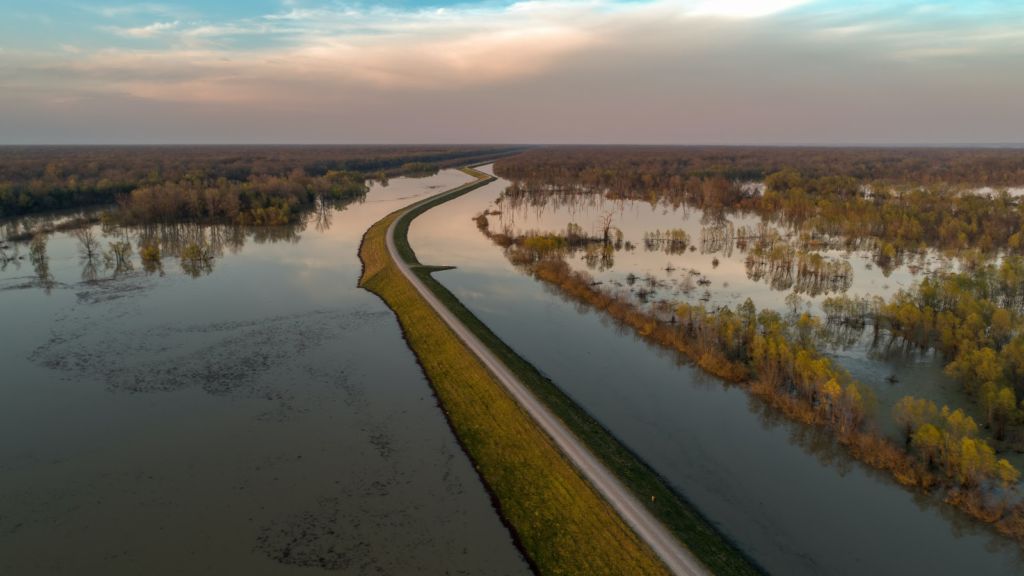Beyond Property Protection:
How Communities Can Invest in Flood Mitigation
There are three main things you can do to protect your property from losses before a flood: buy flood insurance, install structural protections, and devise a flood safety plan.
But what about your neighbors, your city, and your state?
Flooding can have devastating lasting impacts on entire communities years after a flood strikes, especially if their residents don’t have all three components of protection prepared beforehand.
Residents, local governments, real estate agents, and flood insurance agents can all work together to strengthen their community’s flood mitigation. The extent of necessary action will depend on the area’s flood risk, but these three strategies can help any community establish a baseline preparedness for a flood of any size.
1: Lead a Flood Risk Awareness Campaign
Anywhere it can rain, it can flood. But many Americans don’t know that they live in an area that has a flood risk.
In communities along the southern Atlantic coast, hurricane season is an annual reminder of the dangers of flooding. But in an inland state like Nebraska, long dry periods can push flooding to the back of one’s mind until a historic event like the 2019 Midwestern floods hits.
Having flood insurance is the single best way for property owners to prevent financial losses after a flood. In order to get the coverage they need, they’ll need to understand their flood risk first.
These community members can lead a three-pronged flood risk education campaign:
- Insurance agents can proactively educate their customers about flood risk.
- Real estate agents can disclose properties’ flood history and flood risk to prospective buyers.
- Local governments can spread awareness in their communities about the importance of having flood insurance.
One in three flood claims come from areas with a low or moderate flood risk. Communities outside of high-risk flood zones aren’t exempt from the need for flood awareness.
If you’re an insurance agent, head to our Agent Resources for more information about flood education.
2: Invest in Structural Flood Mitigation: From Trees to Levees
Beyond individual homeowners adding property-level structural protections like gutters and flood vents, communities can undertake a number of projects that minimize flood damage collectively.
Some common community structural flood mitigation projects are…
- Levees
- Dams
- Floodwalls
- Jetties
- Retention ponds

These projects range widely in cost and scale, but just one jetty could sizably reduce the amount of water that floods an area during a storm.
The US Army Corps of Engineers is the federal agency responsible for executing and maintaining structural mitigation projects, while a number of smaller organizations can assist at the local level. The USACE is a good place to start when consulting experts about a flood mitigation project.
An easy and inexpensive flood mitigation strategy that any community can execute is simply planting more trees. A number of studies have shown that integrating trees into stormwater management design can help control runoff, reduce erosion, and provide physical shields against floodwater.
3: Apply for Funding for Large Flood Mitigation Projects
If your community would benefit from a large-scale infrastructure project such as a dam renovation, there are a number of grants and funding opportunities available.
FEMA offers Flood Mitigation Assistance (FMA) grants to states, local communities, and federally recognized tribes and territories. FEMA chooses recipients based on the cost-effectiveness and potential impact of the proposed plan.
There are also a number of state funding resources like the Texas’ Flood Infrastructure Fund and California’s Urban Flood Protection. Many of these programs provide guidance in planning flood mitigation projects in addition to funding.
Check your own state and local government’s websites for more information about applicable funding sources.
Proactive Communities Are Resilient Communities
As a property at the top of a hill will have a different risk profile than one at the bottom, it’s no doubt important for property owners to take their own steps toward flood preparedness.
But as a whole, communities can take action to significantly reduce the impact of flooding when they act long before the water arrives. Flood insurance agents, real estate agents, and local governments can raise better flood awareness and help property owners get financial protection, while local governments can invest in structural mitigation and seek additional funding if they need it.
Head to our Intro to Flood resources to learn more about the basics of flood insurance.
Blog Articles
